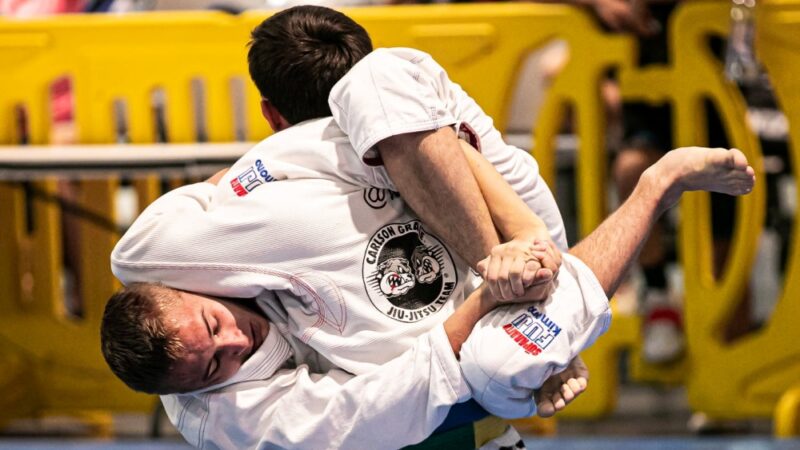Guest post by Evolve MMA, Asia’s premier championship brand for martial arts. It has the most number of World Champions on the planet. Named as the #1 ranked martial arts organization in Asia by CNN, Yahoo! Sports, FOX Sports, Evolve MMA is the top rated BJJ gym in Singapore.
Confidence in BJJ lies in a grappler’s ability to escape from inferior positions. Knowing how to escape from someone who wants to smash you serves as a safety net and gives you the conviction to be creative on the mats. It may be an unconventional approach to BJJ, but traps that lead to submissions can also be set up from inferior positions and are guaranteed to turn heads.
A great example of this is the buggy choke, a submission that’s typically applied from bottom side control. In this article, we will talk about the buggy choke in BJJ.
What Is The Buggy Choke?
There are two ways to complete the triangle in submission grappling. The first is trapping the opponent’s head using your legs (leg triangle), and the second is using your arms (arm triangle). The triangle is the most versatile technique in BJJ as it can be applied from all positions and can even be used to enter leg entanglements. Fundamentally, both the leg and arm triangles have the same goal of disrupting the opponent’s blood flow in the carotid arteries of the neck.
Now, how does the buggy choke relate to the triangle? The buggy choke is a mix of a leg and arm triangle choke that is usually used from bottom side control. While this may sound confusing, it is performed by looping your arms underneath your legs to trap the opponent’s head and arm below your armpit. The opponent’s head and arm are placed on the side of your rib cage while locking your legs in a triangle. Now without further ado, let’s look into detail how the buggy choke is performed.
The Steps To The Buggy Choke
Before attempting the buggy choke, there are two essential steps to practice, as this submission requires flexibility and proper positioning.
To start, lay on your back and reach up to your shin. You should be able to reach your elbow, up to your hamstring, kinda like doing an armbar on yourself. When laying flat on your back (even with long arms), getting your biceps to your knee pit can be difficult, which is the ideal arm position for the choke. You must turn your body to the side, get up to your elbow, and push off the mat. You cannot do it halfway in live training, as the opponent can flatten you back on the mat.
Remember to get up on your elbow as far away from your body as possible so that when the opponent pushes you back on the mat, you can use the momentum to get up as you extend your arm. As you sit up to get your body bladed, you do not want to curl your arms extensively to reach your arms behind your knee. Keep your leg, and arm relaxed as you extend. While lying on your side, post your elbow on the mat, and extend your arm as you pump your top leg up to get your bicep perfectly underneath your knee. This is the first step to locking in a tight buggy choke.
Next, point your toes upward (dorsiflex) and lock your bottom leg on top of your top leg as if doing a triangle. From this position, continue to blade your body, allowing you to post your hand on the mat, leading to more options. Never let go of the “uppercut” position of your arm the whole time it is trapped underneath your leg as you finish by locking both your arms with a gable grip.
The buggy choke can be a great technique in the hands of a tricky grappler. While there are different ways to escape side control, using the buggy choke as a threat can open up many opportunities for you to recover back to a safer position.
The Ruotolo Buggy Choke
The Ruotolo brothers are renowned for their wins via the buggy choke. Below are their three critical details for a successful buggy choke.
First, you should not lay flat on your back when doing a buggy choke. Often in Jiu-Jitsu, creating space and entering different set-ups while laying flat on your back is difficult. You have to angle yourself, facing the opponent, because reaching your arm to your leg will be nearly impossible by completely laying flat on the mat. To finish the buggy choke, you must have your arm behind your knee as you lock your hands together.
It is critical to relieve the opponent’s shoulder pressure from side control by turning your hips towards them instead of lying flat on your back. In this way, you have a lot of space, making it easier to reach your hand to your leg and lock in the choke.
The following key detail is when the opponent pushes you back to the mat. While you may submit most opponents once the choke is locked and tight, some are simply too tough and stubborn to submit. To add more pressure to the choke, curl your lat and lean into the opponent, like doing a side curl. This will make the space between your arm and hip as small as possible.
Lastly, your heel should be pointing towards the floor after locking the buggy choke, with your arms clasped and legs triangled. Remember that your locking leg should be pointing towards the mat as if you are trying to stand on the same leg. This helps build crushing pressure to finish the choke.
Conclusion
One of the exciting things about BJJ is that new techniques are still developed even today. While the buggy choke is a perfectly viable technique, we encourage you to talk to your coach first if you want to add it to your game. This is one of those submissions where flexibility is a necessary trait to have.
If you’d like to know more about this technique, please check out the highlights of the Ruotolo brothers. Tye and Kade are absolutely amazing at what they do, and you’ll surely learn a lot by watching them roll.
Learn Grappling’s Craziest New Submission With The Ruotolo Brothers Teaching The Secrets Behind Their Signature Buggy Choke – No Crazy Flexibility Needed!
- The buggy choke has been shown effective, even against elite competition, and now you can see what makes this innovative attack so powerful.
- The Ruotolo brothers, Tye and Kade, have become known for this submission hold, pulling it off against high level grapplers – now you can learn directly from them.


















